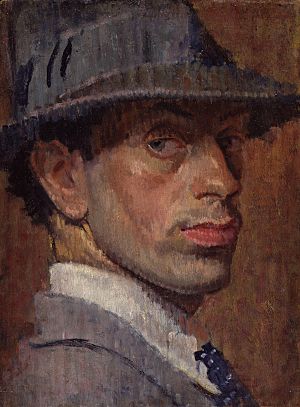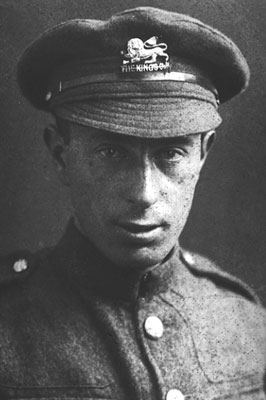Isaac Rosenberg facts for kids
Quick facts for kids
Isaac Rosenberg
|
|
|---|---|

Self-portrait of Isaac Rosenberg, 1915.
|
|
| Born | 25 November 1890 Bristol, England |
| Died | 1 April 1918 (aged 27) Fampoux, Pas-de-Calais, France |
| Cause of death | Killed in action |
| Occupation | Poet, artist |
Isaac Rosenberg (born November 25, 1890 – died April 1, 1918) was a talented English poet and artist. He is best known for his powerful poems about the First World War, especially those written from the trenches. These poems are considered some of the most important works from that time.
Contents
Early Life and Artistic Journey
Isaac Rosenberg was born in Bristol, England. He was the second of six children. His parents, Barnett and Hacha Rosenberg, were Jewish immigrants from what is now Latvia. In 1897, his family moved to Stepney, a poor area in the East End of London with a large Jewish community.
Isaac went to St. Paul's Primary School and later to Baker Street Board School. He showed early artistic talent. In 1902, he was allowed to take classes at the Arts and Crafts School in Stepney Green. In 1905, he started an apprenticeship with an engraver in Fleet Street.
Isaac was very interested in both poetry and art. He took evening classes at Birkbeck College. In 1911, he left his apprenticeship. He managed to get enough money to study at the famous Slade School of Fine Art in London. While there, he studied with many artists who would become well-known.
He started writing poetry seriously. In 1912, he published a small book of ten poems called Night and Day. He also showed his paintings at the Whitechapel Gallery in 1914.
Seeking Health and Facing War
Isaac suffered from a lung condition called chronic bronchitis. In 1914, he hoped to get better by moving to a warmer place. He went to Cape Town, South Africa, where his sister lived. A Jewish charity helped pay for his trip.
Soon after arriving in Cape Town, he wrote a poem called On Receiving News of the War. While many people at the time wrote about war as a brave sacrifice, Isaac was critical of it from the very beginning. He felt better in South Africa and hoped to find work as an artist back in Britain. So, he returned home in March 1915.
He published another collection of poems called Youth. However, he couldn't find a steady job. At the end of October 1915, he decided to join the British Army. He asked for half of his army pay to be sent to his mother.
In a personal letter, Isaac explained why he joined the army. He wrote, "I never joined the army for patriotic reasons. Nothing can justify war. I suppose we must all fight to get the trouble over." This shows he didn't believe in war, but felt it was necessary to end it.
Serving in the First World War
Rosenberg was assigned to the 12th Bantam Battalion of the Suffolk Regiment. "Bantam" was a term for soldiers who were shorter than the usual minimum height. He was later transferred to other regiments. On June 3, 1916, he was sent to the Western Front in France. This was where much of the fighting in the First World War happened.
He continued to write poetry while serving in the trenches. Some of his most famous poems from this time include "Break of Day in the Trenches," "Returning We Hear the Larks," and "Dead Man's Dump." These poems give a powerful and honest look at life and death in the war. In December 1916, Poetry Magazine published two of his poems.
In January 1917, Isaac reported sick. His family and friends asked his officers to move him away from the front lines. He was transferred to a different unit. There, he delivered barbed wire to the trenches. He wrote his poem Dead Man's Dump during this period.
He had a short leave in London in September 1917. After returning, he fell sick again in October and spent two months in a hospital. He was then transferred to the 1st Battalion of the King's Own Royal Regiment. He tried to transfer to one of the all-Jewish battalions, but his application was not found.
On March 21, 1918, the German Army launched a major attack. A week later, Isaac sent his last letter home. It included a poem called "Through These Pale Cold Days." He then went to the front lines with more soldiers.
Isaac Rosenberg was killed on the night of April 1, 1918. He had just finished a night patrol. He died in a town called Fampoux, in France. He was first buried in a mass grave. Later, in 1926, his remains were re-buried in a military cemetery. His gravestone is marked with his name and the words, "Buried near this spot," and "Artist and Poet."
Legacy and Recognition
Isaac Rosenberg's work continues to be important today.
- His self-portraits can be seen in famous galleries like the National Portrait Gallery and Tate Britain.
- A special blue plaque honoring him is placed outside the Whitechapel Gallery in London.
- On November 11, 1985, Isaac Rosenberg was honored in Westminster Abbey's Poet's Corner. A stone was unveiled there to remember 16 Great War poets. The words on the stone were written by another war poet, Wilfred Owen: "My subject is War, and the pity of War. The Poetry is in the pity."
- Many people consider his poem "Break of Day in the Trenches" to be one of the greatest poems of the war.
- His life has been featured in books and radio documentaries, helping more people learn about his powerful poetry and art.


